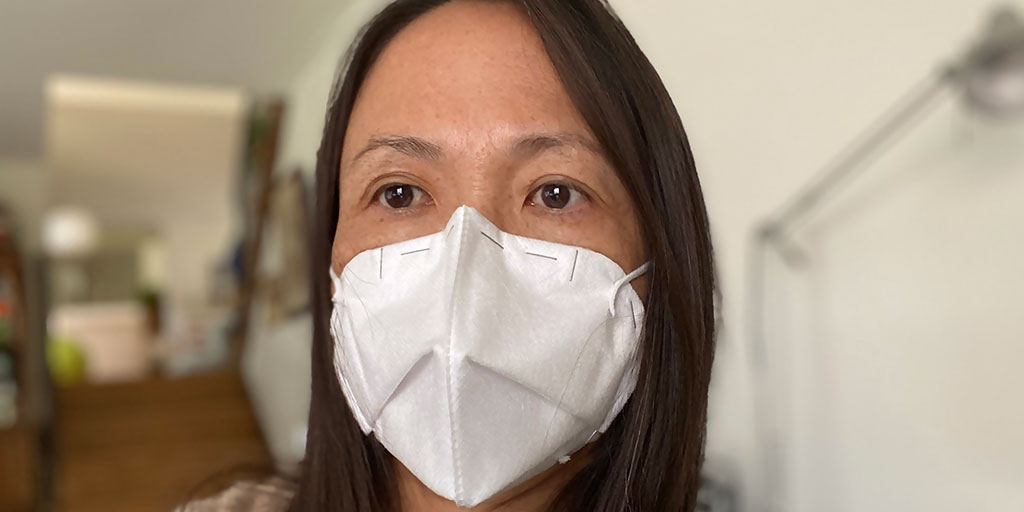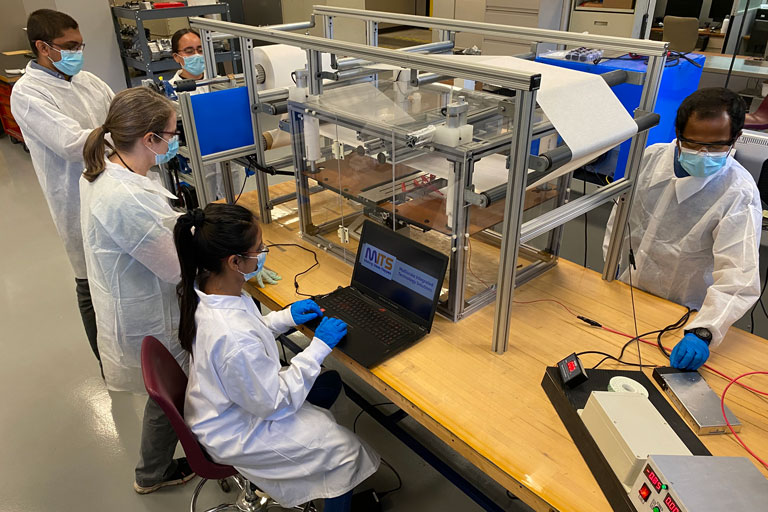Early in the pandemic's progress through the U.S., IU faculty turned their expertise to the challenge of creating critically needed safe and effective masks.
Better, safer masks for all

When Jiangmei Wu’s brother called from Hong Kong in late January 2020, he asked if she could find surgical masks to send him amid the extreme shortage there. Or better yet, could his sister, an artist and designer, come up with a better mask design altogether?
That’s how Wu, an associate professor at the Ezkenazi School of Art, Architecture, and Design at IU Bloomington, found herself using the ancient art of origami to create face masks. It took only a few hours for her to come up with a simple prototype design that can be easily folded and adjusted to fit a person’s unique face profile.
By mid-April, as the need for face masks began to escalate, the New York Times discovered Wu’s work, catapulting her mask-making technique into the national limelight. A video (below) demonstrating her technique has been viewed more than 238,000 times.
Description of the video:
[Video: Indiana University logo appears on black screen]
[Video: Music plays]
[Video: Folding a Mask with Jiangmei Wu appears followed by materials list]
Materials:
- Fold a Face Mask template
- Scissors and stapler
- 1x Twist Tie 4”
- 2x Elastic Strips 7”
- 1 HEPA filter (designs may differ).
[Video: image of mask template appears]
[Video: images of mask being folded by woman's hands appear as steps appear on red bar at bottom]
Lay out filter so it is flat and even. May need to adjust according to design of filter.
Step 1: Remove cardboard tab from filter.
Step 2: Align and trace the template on the filter.
Step 3: Cut outside the lines. Optional: cut off excess fold.
Step 4: Align template and mark pleating points.
Step 5: Place twist tie in the top tab and fold tab over it.
Step 6: Staple shut.
Step 7: Flip mask over and fold in half.
Step 8: Pinch the first pleat point and fold. (Note the second mark is the bottom of your first pleat fold.
Step 9: Crease second pleat line and fold. Bring first fold and second fold together.
Step 10: Staple folds together and repeat on opposite side.
Step 11: Add more staples around edges to secure mask. If staples on the inside of the mask are uncomfortable, flip the direction of the stapling.
Step 12: Staple elastic bands to the mask. (Mark both sides of mask for easy stapling.)
[Video: Indiana University logo and For more information, visit research.impact.iu.edu/coronavirus appear on black screen]
After finding Wu’s video and origami mask instructions, a viewer from Florida wrote: “Huge heartfelt thanks. I’ve folded and stapled two face masks and they look very promising indeed. Basketball aside, I am a new and genuine fan of IU.”
As the pandemic began to hit hard in Indiana, IU faculty and staff converted labs and 3D printers into hubs churning out face shields and other protective equipment to support the doctors, nurses and other frontline health care workers.
A special virus-killing fabric
At IUPUI, a team of researchers succeeded in developing a special mask made of fabric that kills coronaviruses on exposure. Called “electroceutical," the fabric, made by Vomaris Innovations Inc., uses V.Dox Technology, a proprietary dot-matrix pattern of embedded microcell batteries that create an electric field and wirelessly generate a low level of electricity when moist. Coronaviruses rely on electrostatic interactions to attach to their host. The electric field-generating fabric disrupts the electrostatic forces the virus needs. Led by Chandan Sen, director of the Indiana Center for Regenerative Medicine and Engineering at the IU School of Medicine, the IU researchers demonstrated that the virus's ability to infect is eliminated after contact with the fabric.
Working with Vomaris, Sen and his team provided a critical new option for the personal protective equipment that has become essential to protecting lives during the pandemic.
Description of the video:
[Music fades in] Video: inside the School of Medicine we see a sign with IU logo and title in black, "INDIANA CENTER FOR REGENERATIVE MEDICINE & ENGINEERING SCHOOL OF MEDICINE] COVID-19 as we all know, is highly infectious [A medium shot of a man wearing a lab coat appears. Lower 3rd: IU logo Chandan K. Sen PHD Associate Vice President for Military and Applied Research. The IU trident appears in the top right corner] Especially healthcare providers they're constantly exposed to people that have [Video: an orange-red box is seen with the word biohazard and symbol for it] this infection and although they are wearing for example [A researcher in a face mask while working at a computer] say facemask [A table with multiple medical tools, pens, and a journal are seen some of these viruses are adhering [A close up of a facemask on a counter] to the exterior of this mask and when you are [A researcher at a workstation takes off their facemask] taking off the mask [Animation of COVID-19 viruses is seen moving] inadvertently you end up spreading infection so our challenge here is once this virus comes in contact with the fabric of the mask that it no longer is able to infect in there [A counter with two laptops showing graphs are seen] we tried to put some time into understanding the physical make of this virus and are there some perhaps weak [A researcher works at a computer station with monitoring software] points that we could target and as we kept understanding from the [A researcher wearing a mask and gloves holds a medical tool and tube] literature on how the virus is constructed and the fact that it relies on [animation of electricity] electrostatic forces we thought then our dressing [ a computer screen showing moving particles from a monitoring instrument capable of disrupting those electrostatic forces [A researcher picks up a face mask off a counter with multiple medical tools and we started testing it and the end results seem very promising [ A man wearing glasses puts on the prototype facemask] so pharmaceutical as we know [Two Therma Scientific machines operate on a counter, one has a biohazard symbol with the word BIOHAZARD on it] are drugs. In the case of a electroceutical, you're using electrical [Animation close up of prototype fabric showing positive and negative charges interacting] forces to treat a disorder it is a bit unique in that you're using a very weak electric field which is not harmful to humans we already know that but is capable of dismantling [Animation of bacteria landing on skin and electrically interacting with the skin bacterial infection we are currently working [Animation of prototype fabric landing on pile of bacteria and electric charges passing between the fabric and bacteria appear on fungal infection and now we see it can also incapacitate if you will viruses. Take textile [Dr. Sen holds the prototype mask showing the geometric pattern of silver and zinc] and you print certain metals in this case silver and zinc in a given geometric pattern fabric does not [Dr. Sen's hands touching and pinching the prototype mask] have wire the fabric does not have battery yet when it comes in contact with any aqueous solution that has ions in it the [Video of a square strip of prototype fabric with pluses on it is touched by Dr. Sen's hands] fabric itself generates electricity and this electricity is enough [Video fades to the prototype facemask and Dr. Sen's turns the mask over to reveal white fabric on the inside] to block the ability of the virus to infect. The area of electroceuticals is now rapidly rising [A woman holding medical tool and tube and a cohort stands behind her monitoring her work they both wear gloves and a facemask] not just drugs and chemistry that other physical forms of intervention [Close-up of a white coat with IU logo and embroidered words "SCHOOL OF MEDICINE" on it appear] can also be used for healthcare. [IU logo, INDIANA UNIVERSITY, research.impact.iu.edu/coronavirus fade in and fade out, music fades out]Combating COVID-19 with copper at nanoscale
Safer, better masks were also the focus of work by researchers at IUPUI’s Integrated Nanosystems Development Institute. Applying a patented technology developed at IUPUI, the research team created reusable face masks using copper, a metal known for its antibacterial properties. The technology can coat mask fabric with a layer of protection inlaid with copper nanoparticles that disable virus particles as they reach the surface, providing a superior level of protection. Beyond face masks, the technology could be applied to other methods for fighting COVID-19, too, such as HEPA filters found in HVAC systems to create virus-free air circulation in buildings and hospitals.
Mangilal Agarwal, director of the institute and professor of mechanical and energy engineering and Hamid Dalir, associate professor, led this work. They are looking to commercialize this technology through the startup they created, Multiscale Integrated Technology Solutions. The commercialization of their technology has the potential to greatly impact lives here in Indiana and around the world – providing a safe solution against the spread of COVID-19.


